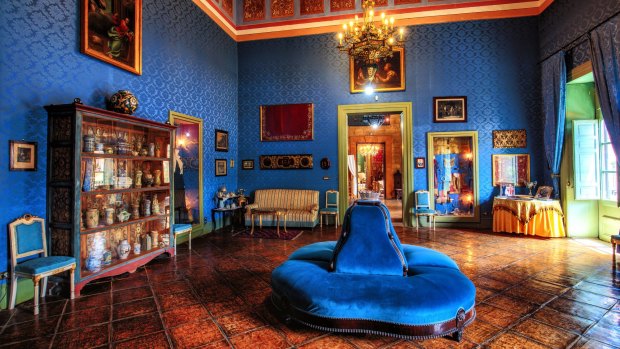This was published 5 years ago
Palazzo Conte Federico, Sicily: A date with a Sicilian countess

Guided tours take in the flamboyantly-decorated spaces at Palazzo Conte Federico. Credit: Shutterstock
Dusk is approaching as we walk through the higgledy-piggledy knot of narrow, stony backstreets in Palermo's Centro Storico. The still-warm air of the Sicilian capital is infused with tolling church bells, wheezing Vespa engines and children laughing and kicking a football around. Laundry flaps from apartment balconies and on one street corner, a group of young Africans mingle by a banner promoting the plight of refugees arriving in Sicily by boat, seeking safe haven.
The Mediterranean's biggest island has been cultivated, over three millennia, by a succession of immigrants and invaders, from Phoenicians and Greeks to Moors and Aragonese, and, of course, the Italians, who annexed Sicily into their newly-unified kingdom just over 150 years ago. With this cosmopolitan mash-up in mind, it's not surprising to learn that our host for the next few hours is originally from overseas, too.
Tall, lean and glamorous, with long blonde hair and bronzed skin, Countess Alwine is waiting for us at the top of the sweeping red marble staircase of Palazzo Conte Federico, one of the abundant palazzi (palatial buildings) clustered amid the lanes, avenues and squares of Palermo's old quarter. Born in Austria, to a "fairly normal" background, the countess was wooed and wed by Count Alessandro Federico, a Palermitan descendant of Frederick II, who, in the 13th century, was King of Sicily and Holy Roman Emperor. Scores of Palermo's religious and aristocratic palazzi were destroyed in World War II bombing, and many that did survive were later revived as flats, galleries or hotels, including Grand Hotel Piazza Borsa (our base for the first half of our nine-day Collette Splendid Sicilia tour).
The count's palace has been the family home, however, since the 16th century. Constructed above a section of Palermo's ancient Punic-Roman city walls, it's attached to an Arab-Norman defence tower built in the Middle Ages. Still oozing a medieval feel – there are even suits of knights' armour on display – the dimly-lit tower room is among the flamboyantly-decorated spaces we're shown on a guided tour of a palace, which was restyled over the centuries, inspired by architectural fashions, and lovingly restored by Alwine and Alessandro, who live here with their two grown-up sons.
We're led through a series of rooms and halls variously adorned with Murano glass chandeliers, ceiling frescoes and Arab-esque lampshades, cabinets of antiques, busts and ceramics, colourful fabric sofas and armchairs, walls laced in silk, weapons and family portraits, and floors carpeted with exotic rugs, mosaics of Sicilian villages and landmarks and the coat of arms of the House of Hohenstaufen, the count's family, which derived from a dynasty of German kings. Also here is a grand piano that the composer, Richard Wagner, played on a trip to Palermo in 1882, plus scores of medals and trophies, some won by the countess for her swimming endeavours; others by the count, a vintage car aficionado, for his motor racing (we'd passed one of his classic Italian cars after entering the palace through its leafy interior courtyard).
As fascinating as the countess' anecdotes are, regarding the building's history and eclectic decor, what our group really wants to know is: how did she meet her husband? The story goes that Alwine, a trained soprano, who grew up in Salzburg, the city of Mozart, was invited to perform at a waltz ball at the Austrian embassy in Rome. Alessandro, attending as a guest, was reportedly smitten. "A little later I moved to Taipei to study Chinese, and he found me there," explains Alwine. "He fell on his knee and proposed, with the family engagement ring. He claimed he would jump into the river if I said 'no'.
"I didn't speak any Italian then, so I didn't know how to say 'no' anyway!"
We end our visit with aperitivo, comprising Palermitan "street food" such as arancini and sfincione (Sicilian pizza) and wines from the count's vineyard – a fruity white chardonnay and ruby-red nero d'avola, Sicily's main indigenous grape. As we sip and snack, the countess sings for us. We can't understand a word – it's an old German tune by a poet who had known an ancestor of her husband's – but as her voice radiates around this beautiful palace, that doesn't matter one bit.
TRIP NOTES
A guided tour of Palazzo Conte Federico is included on Collette's nine-day Splendid Sicilia tour. Available on dates between February and November, the trip is priced from $2749.
See gocollette.com
Sign up for the Traveller newsletter
The latest travel news, tips and inspiration delivered to your inbox. Sign up now.